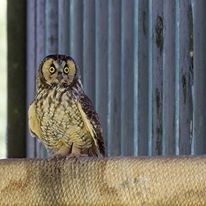Recently, a long-eared owl underwent one of AIWC’s first onsite surgeries in several years to repair an exposed fracture. The vets are optimistic about him making a full recovery.
While the wide eyes, orange facial disks, and tall feather tufts of the long-eared owl give this bird the appearance of being ever-startled, the close set feathers atop their heads are meant to protect them from being surprised by other animals. By elongating their bodies and ear tufts, long-eared owls camouflage themselves by looking like tree branches to avoid being seen by possible predators. As a quite slender bird of prey, long-eared owls risk predation from larger raptors like great-horned owls and bald eagles. Magpies, crows, and hawks have also been known to prey on long-eared owl eggs and nestlings.
Long-eared owls are almost strictly nocturnal, hunting small rodents and birds at night. When they are not caring for young owlets, long-eared owls will roost in groups, but are among the most secretive owls and are rarely heard or seen. These birds prefer dense forests and are partially migratory so you may be lucky enough to see one this season travelling slightly farther south of his/her breeding range to overwinter.
If you would like to help support the long-eared owl’s recovery, or any other animal in our care, consider adopting an animal, donating items on our wish list, or volunteering at the centre. If you find injured wildlife, please call the centre for assistance at 403.946.2361.
By Stephanie Ruddock, AIWC Volunteer
Sources:
https://www.simplywildcanada.com/wild-species/birds-of-canada/owls-of-canada/
https://aep.alberta.ca/fish-wildlife/wild-species/birds/owls/long-eared-owl.aspx







1 thought on “Long-eared Owl”
Is this the owl my husband and myself dropped off from High River Sept 29 (we took him to fish creek 24hr vet) He had a visible injured left eye and couldnt fly? I would love to know how his recovery is going? Thank You